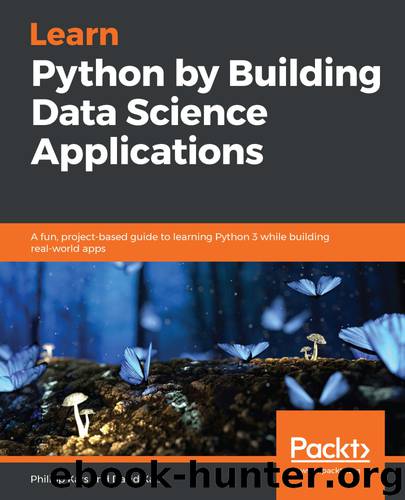Learn Python 3.7 by building applications by Philipp Kats

Author:Philipp Kats [Philipp Kats]
Language: eng
Format: epub, mobi
Tags: COM000000 - COMPUTERS / General, COM082000 - COMPUTERS / Bioinformatics, COM006000 - COMPUTERS / Buyer
Publisher: Packt
Published: 2019-08-30T13:00:38+00:00
Time
Another column is time. Now, pandas has a built-in DateTime parser and a very good one! Just use pd.to_datetime() on your scalar value or a collection. In this case, however, it won't work, and neither will any external packages that usually help (dateparser is our favorite). And all that because cells describe a time range, and not just one specific date.
Again, let's (at least, for now) see whether we can make our life simpler. Indeed, we probably don't care about specific dates—all we need is the month and year. Luckily, all months are properly stated and uniform—and pd.to_datetime can parse them. So, all we need is to correctly extract two month-year pairs from each.
Now, it seems hard to define one regular expression that will work here. Instead, we can try to get all years (we know all of them are four-digit numbers, starting with 19) and all months (there are just 12 variants). Then, we can combine them, using the year twice if there is only one value.
Let's try it out! First, we define the patterns:
d = ('January', 'February', 'March', 'April', 'May',
'June', "July",' August', 'September', 'October', 'November', 'December')
Download
Learn Python 3.7 by building applications by Philipp Kats.mobi
This site does not store any files on its server. We only index and link to content provided by other sites. Please contact the content providers to delete copyright contents if any and email us, we'll remove relevant links or contents immediately.
| Anatomy | Animals |
| Bacteriology | Biochemistry |
| Bioelectricity | Bioinformatics |
| Biology | Biophysics |
| Biotechnology | Botany |
| Ecology | Genetics |
| Paleontology | Plants |
| Taxonomic Classification | Zoology |
Sapiens: A Brief History of Humankind by Yuval Noah Harari(14321)
The Tidewater Tales by John Barth(12626)
Mastermind: How to Think Like Sherlock Holmes by Maria Konnikova(7279)
Do No Harm Stories of Life, Death and Brain Surgery by Henry Marsh(6906)
The Thirst by Nesbo Jo(6881)
Why We Sleep: Unlocking the Power of Sleep and Dreams by Matthew Walker(6657)
Life 3.0: Being Human in the Age of Artificial Intelligence by Tegmark Max(5516)
Sapiens by Yuval Noah Harari(5324)
The Longevity Diet by Valter Longo(5042)
The Body: A Guide for Occupants by Bill Bryson(5030)
The Rules Do Not Apply by Ariel Levy(4910)
The Immortal Life of Henrietta Lacks by Rebecca Skloot(4550)
Animal Frequency by Melissa Alvarez(4428)
Why We Sleep by Matthew Walker(4394)
The Hacking of the American Mind by Robert H. Lustig(4339)
Yoga Anatomy by Kaminoff Leslie(4333)
All Creatures Great and Small by James Herriot(4271)
Double Down (Diary of a Wimpy Kid Book 11) by Jeff Kinney(4242)
Embedded Programming with Modern C++ Cookbook by Igor Viarheichyk(4141)
